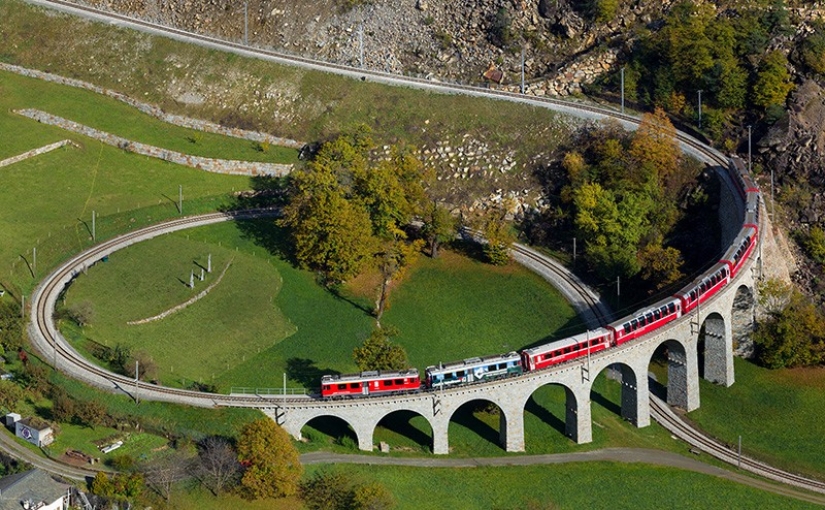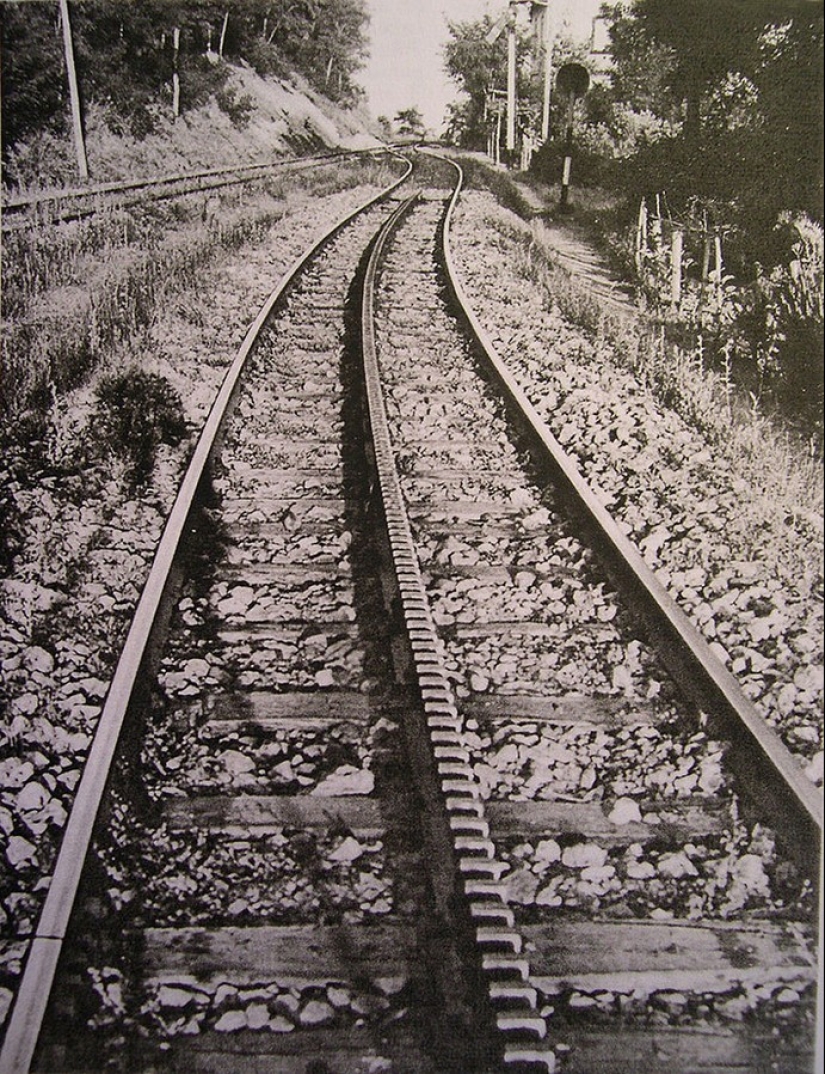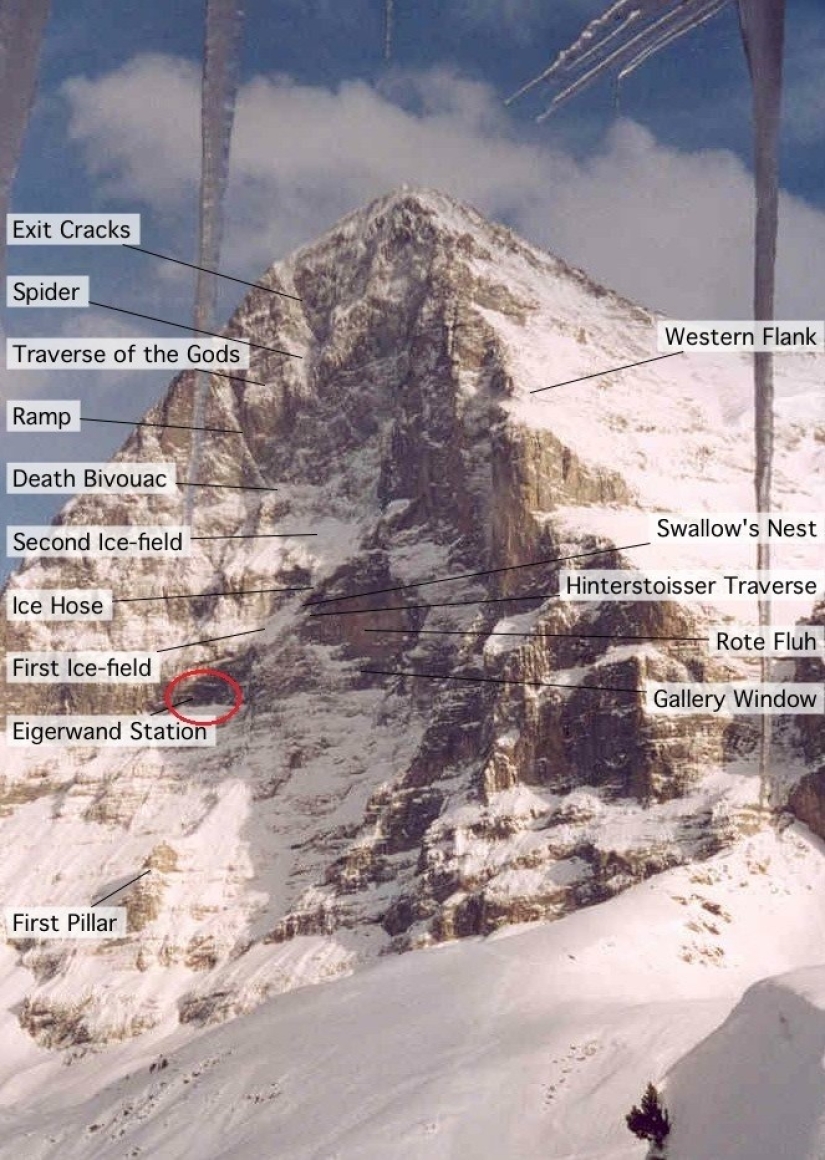Top 5 most unusual Railways of Switzerland
At the end of the XIX century on the "roof of Europe", in the Alps, became like mushrooms after the rain appeared the mountain Railways, many of which were at the time an engineering marvel. Underground stations in the depths of towering peaks, the spiral tunnels and viaducts, trains, climbing a slope of 40% for km altitude, we have selected for you five of the most unusual historic Railways of Switzerland.


For the second half of the nineteenth century, the Swiss realized that along with the famous banks of the main competitive advantage of their small country is breathtaking Alpine nature. However, travelers still had to bring in remote mountainous areas.

In the last quarter of the century, technical progress is finally allowed to find suitable engineering solutions: new luxury hotels on the slopes of the Eiger, Matterhorn or Jungfrau travelers and skiers had to deliver the first steam, then electric traction using rail transport.
The highest mountain railway in Europe — Jungfraubahn

Eiger, mönch and Jungfrau, is the most famous mountain triad of the Bernese Oberland, the dream and the curse of many climbers.

Even with the 1860‑ies, there were plans for the construction of the railway, which was supposed to pass right through the thickness of the first two peaks and finished on the Jungfrau, the highest of them (4158 meters).

According to various (mostly financial and engineering) reasons, the project was able to proceed only after three decades. In 1896, a Swiss businessman Adolf Guyer-Zeller started the construction of a 9‑kilometer line, taking its origin from the already existing pass the Kleine Scheidegg of the Eiger from the train station.

It would seem that the length of the new road is not impressive, especially in comparison with the 1000 km of Alpine projects of the Chinese. However, in this case, it mattered quite different: Jungfraubahn was built 100 years before, and appropriate technology and by private initiative. The line had to overcome a difference in altitude of almost 1500 meters, and 7 of 9 kilometers of its length, it was necessary to punch right through the massive mountains of the Eiger and the mönch.

This tunnel was built for 14 years, from 1898 to 1912, initially around the clock in three shifts. When blasting killed several of the workers, and in 1899 the process has stalled after the death of the main investor, Adolf Guyer-Zeller. Had to change the original route of the road.

Jungfraubahn was to end at the top of the Jungfrau, but following the death of the mastermind of the project's financial difficulties, as well as complex geological conditions in the intended end point of the road brought only to the Jungfraujoch, between the Mönch and the Jungfrau.

Of course, conventional rail line to build in this case it was impossible. Just 9 kilometers, the train had to climb 1393 meters, with the pass of Kleine Scheidegg (2061 m above sea level) up to the Jungfraujoch (3454 meters). For such upgrades needed to build a rack railway to the road.

Such highways are equipped with additional (third) gear rail, for which clings to one or two as gears, already installed on rolling stock. Technology, received a special distribution just in Switzerland, where there are several dozens of such lines, makes it relatively easy and safe to overcome the steep mountain slopes.

For Jungfraubahn was selected metre gauge (1000 mm wide), the line was originally electrified (used three-phase current).


The first two kilometers she overcame the earth's surface. At the foot of the Eiger in the background of her famous North wall, which claimed many lives climbers, built the first station "Eigergletscher" ("the Eiger Glacier").


The remaining three road station underground, or rather mountain. As the dwarves of the epic "Lord of the rings", the builders erected Jungfraubahn directly deep within the mountain station complexes, and combined with observation decks. Station "Eigerwand" ("wall of the Eiger") located in the middle of the northernmost walls and opened in 1903.


The train on the way up stay here for five minutes. With passenger platforms outputs are arranged on the viewing Windows, which from the height of 2865 metres, you can enjoy fantastic panoramic views of the valley of Grindelwald. The same window at the time was used to rescue climbers who dare to conquer the North face of the Eiger, but not calculated their strength.


General view Eigernordwand, where red represents the station exits "the Wall of the Eiger".


In 1905 at the height of 3158 metres again in the depths of the Eiger, but its South-Eastern slope opened station "Eismeer" ("Ice sea").

Here the trains are also doing a five-minute stop so that passengers could enjoy not valley and the Lower Grindelwald glacier. Those interested can send directly from the interior of one of the most famous Alpine peaks a postcard home.

Finally, the third (and which has become final) station Jungfraujoch earned only in 1912. Located on the eponymous pass between the mountains mönch and Jungfrau, she took 3454 meters, becoming, thus, the highest railway station to all parts of the world. That is why it is nicknamed the "top of Europe".

Here visitors can come to the surface, where there are several tourist sites: the observation deck with panoramic views of the surrounding area, including the longest Alpine glacier, the Aletsch glacier, restaurants, Museum, post office, ice Palace.

Here at the height of 3571 metres, and the astronomical Observatory "Sphinx", which is available to the public.

Jungfraubahn, of course, first of all it is a popular tourist destination. By two-car trains annually transport over half a million people.

The ascent takes about an hour, a ticket to "the top of Europe" is 60 Swiss francs (€50).
Open the highest mountain railway in Europe — Gornergratbahn

Jungfraubahn is the highest-altitude railway of Europe, however, seven of the nine kilometres laid in tunnels. In Switzerland in the Canton of Valais at comparable altitudes, there is another, of course, also notched up the road, but it was almost completely paved on the surface.

Gornergratbahn connects the resort town of Zermatt with the mountain gornergratbahn departure stations.

Its length is slightly more than nine kilometers, but due to the short length of the tunnels it was built much faster. Work began in 1896 and lasted only about two years. Partially double-track line with a gauge of 1,000 mm joined existed at the height of 1604 metres of railway station in Zermatt, mountain range gornergratbahn departure stations (3089 m), where the Kulm hotel.

In 1990‑e years in the hotel towers were arranged Observatory with two telescopes.

On the line, the maximum slope which is 20%, there are four tunnels (the longest — 179 metres), two viaducts and a covered gallery with a length of 770 metres, introduced in 1940‑e years in the most dangerous area.


At a considerable section Gornergratbahn a picturesque backdrop for her is Matterhorn mountain, one of the most famous Alpine peaks.



The total height difference is 1485 meters, that is, even more than Jungfraubahn. Line Gornergratbahn electrified (she even became the first Swiss gear road with electric traction), her six stations (many of them are near the hotel). By two-car trains capable of carrying about 2.5 million passengers per hour.


Another interesting object in the road is Riffelalp. In fact, it is a short (a total of 675 metres) tram line, which in summer transports guests of the hotel Riffelalp Grand Hotel from the station Riffelalp directly to the hotel.

In this photo right Gornergratbahn left visible way of Riffelalp.

Serve single-track branch (track width — 800 mm) only two open trailer, battery-powered and was built in 1899.

Despite sharing some toy kind of Riffelalp, it is considered the highest mountain tram line in Europe: the average height above sea level is 2210 metres.
The steepest railway in the world of Pilatusbahn

The Railways Jungfraujoch and Gornergrat maximum slope is 25 and 20%, respectively. Of course, this is not a record, which allows to achieve a gear. In 1889, in the Canton of Obwalden in Central Switzerland, the line was opened, linking the town Alpnachstad with one of the peaks of the mountain massif of Pilatus on lake Lucerne.


The average slope Pilatusbahn is 35% and the maximum is 48% (!). To ensure such a steep ascent wasn't normal gear when the rail wheel had a vertical connection.

Engineer Eduard Locher proposed an elegant solution: double the system (two rails and two wheels) and expand it horizontally.

This solution not only helped to eliminate the threat of jump-out the wheel with the rail, but also ensured the stability of cars during the strong winds common in the area.


The length of the line with a gauge of 800 mm is just 4.6 km. For half an hour one of the ten carriages with a capacity of 40 people each overcomes a height of 1629 metres.

In the end arranged several tunnels. Initially, the movement was used by steam traction, in 1937 the line was electrified.
Locomotive line Furka-Bergstrecke

Unlike Pilatusbahn, has long electrified railway, cog railway, linking towns REALp and Oberwald in the South of Switzerland, is still using locomotive traction.

The line is at its highest point crosses the Furka pass at a height of 2160 meters and has a maximum gradient of 12%.

In 1981, this 18-kilometer stretch of road Furka of Oberlippe after the opening of the tunnel under the Furka pass was closed and abandoned, but after 11 years, only thanks to the initiative of enthusiasts and donations earned again.

The line now operates solely through private investment.

In fact, it is a tourist attraction, where participants have the opportunity to pass on the second tallest rail pass in Europe, to enjoy on the road Alpine scenery and to do it using hot tube fiercely smokestack of a steam locomotive.
The Rhaetian railway is the highest railway line in Europe

There are in Switzerland and outstanding in all respects conventional railroad, whose functioning is no longer required additional gear. The slopes here are not so great, but their extent is much higher, and in addition to tourism, they perform a regular transportation function.


In 2008, the Albula and Bernina, two lines of the Rhaetian railway, the largest narrow-gauge network in the southeastern Canton of graubünden, was in the list of world cultural heritage of UNESCO.

Authoritative international organization noted for their outstanding engineering solution allowed to include in the European transport network previously inaccessible areas of the Central Alps.

Until 1890‑ies of the Railways in the South East of Switzerland was practically absent. Only in the years 1898-1904 opened the Albula line (67 km), and in 1910, its continuation Bernina (61 km), linking a "greater Switzerland" with the Italian town of Tirano through the mountain resort of St. Moritz.

This project has fundamentally breathed new life into the Canton of graubünden, allowing him to become one of the main tourist centers of the country.

Starting in the village of Thusis on the altitude of 697 metres above sea level, the road climbs to the Bernina pass (2253 m), then descends to the Italian border town of Tirano ends at around 429 metres. The slope does not exceed 7%, which allowed to refuse the use of gears. In terms of device movement Albula line and the Bernina quite traditional, except that of narrow gauge (1000 mm wide). Only in some localities they are just on the city streets, Recalling rather the tram.

In total, the turn of the XIX and XX centuries they built a 55 tunnels (including spiral) and indoor galleries, 196 viaducts and bridges.

Among the greatest engineering works stands out the Landwasser viaduct, sectiony curved bridge, one end of which goes into the tunnel. This is a true symbol of the Albula line.

The line Bernina its symbol — spiral viaduct Brusio. It was built to compensate for the height difference, and given the fact that the maximum slope of the road was not to exceed 7%.

Forced engineering solution has become one of the most unusual railway structures in the world.

From the mid 1980‑ies, and especially after the inclusion of the lines in the list of UNESCO WPC Albula line and the Bernina became especially popular among tourists. The roads goes several train cars with panoramic Windows. For example, the Bernina Express in only 4 hours overcomes 127 kilometers between Chur and Tirano, first rising to 1,700 metres, and then down to 1800.

The cost of travel in both directions — from 130 Swiss francs (about €110).

Alpine passes, mountain lakes, pastoral towns with Church and rugged peaks, glaciers and mountain stations, curved viaducts and kilometer tunnels — all of this can be seen with the Swiss Federal Railways.

Built over a century ago, they still represent a remarkable triumph of human genius, unity breathtaking nature and engineering.



Keywords: Europe | History of | Train | Railway | Switzerland | Unusual
Post News ArticleRecent articles

It is impossible to imagine the New Year without citrus fruits, especially tangerines. And on other days it is difficult to refuse ...

There are special fans of second-hand stores who love to rummage through piles of things in search of “something special.” ...
Related articles

Ah, Italy, a beautiful country with divine cuisine, rich history and beautiful landscapes. Here every tourist will find something ...

In the world there are a lot of things covered mystical, sometimes macabre stories. Mirror, bringing misfortune, paintings, causing ...

Fritz Haarmann — German vampire killer, distinguished by remarkable cruelty and cynicism. His victims were young men, as he had ...

"Wash your hands before eating!" — a phrase familiar to us since childhood. The parents explained that with the help of this ...